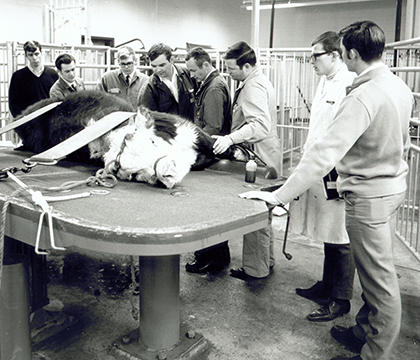
Top graduates constant result of curriculum
When members of the Western College of Veterinary Medicine's Class of 2015 receive their Doctor of Veterinary Medicine (DVM) degrees this spring, they'll join a group of nearly 3,000 people who have completed the college's challenging veterinary program.
By WCVM Today
The origins of the college's DVM program stem back to WCVM's founding dean, Dr. D.L.T. (Larry) Smith, who believed in giving students the basic principles and allowing them time to think. A gifted teacher, Smith followed the Greek historian Plutarch's philosophy,"… that a student's mind should be regarded as a fire to be kindled, not a vessel to be filled."
Guided by Smith's values, a curriculum committee set out in 1964 to devise a program that met the American Veterinary Medical Association's accreditation requirements and the needs of western Canadians.
After months of discussion, the committee gave key recommendations to the University of Saskatchewan Council in 1965. First, students had to complete at least two years of pre-veterinary medicine courses in university before applying to the WCVM. Second, successful applicants would take four years of professional education at the college.
The committee also outlined the DVM program: 128 weeks of school with 30 hours of lectures and labs per week. It included anatomy and biochemistry as well as the "-ologies" — microbiology, physiology, pathology, pharmacology, bacteriology, immunology, virology and parasitology. In their final two years, students studied surgery, medicine, nutrition, radiology, animal husbandry and production, obstetrics and reproduction.
Other than some tweaks and additions, the curriculum remained the same until 2007 when the WCVM moved to a "core-elective" model. Students now take the same core courses in their first two and a half years, but in their third year, they gain more in-depth information in particular interests through elective courses. During their final year, students complete two- or four-week practical rotations and externships in various disciplines and interest areas.
While the college's curriculum has undergone revisions to meet today's demands, one thing remains the same: WCVM continues to produce top graduates who are equipped with a comprehensive, broad-based veterinary education.
With files from WCVM: The First Decade and More by Christopher H. Bigland. Visit www.usask.ca/wcvm/fifty-years
Guided by Smith's values, a curriculum committee set out in 1964 to devise a program that met the American Veterinary Medical Association's accreditation requirements and the needs of western Canadians.
After months of discussion, the committee gave key recommendations to the University of Saskatchewan Council in 1965. First, students had to complete at least two years of pre-veterinary medicine courses in university before applying to the WCVM. Second, successful applicants would take four years of professional education at the college.
The committee also outlined the DVM program: 128 weeks of school with 30 hours of lectures and labs per week. It included anatomy and biochemistry as well as the "-ologies" — microbiology, physiology, pathology, pharmacology, bacteriology, immunology, virology and parasitology. In their final two years, students studied surgery, medicine, nutrition, radiology, animal husbandry and production, obstetrics and reproduction.
Other than some tweaks and additions, the curriculum remained the same until 2007 when the WCVM moved to a "core-elective" model. Students now take the same core courses in their first two and a half years, but in their third year, they gain more in-depth information in particular interests through elective courses. During their final year, students complete two- or four-week practical rotations and externships in various disciplines and interest areas.
While the college's curriculum has undergone revisions to meet today's demands, one thing remains the same: WCVM continues to produce top graduates who are equipped with a comprehensive, broad-based veterinary education.
With files from WCVM: The First Decade and More by Christopher H. Bigland. Visit www.usask.ca/wcvm/fifty-years
